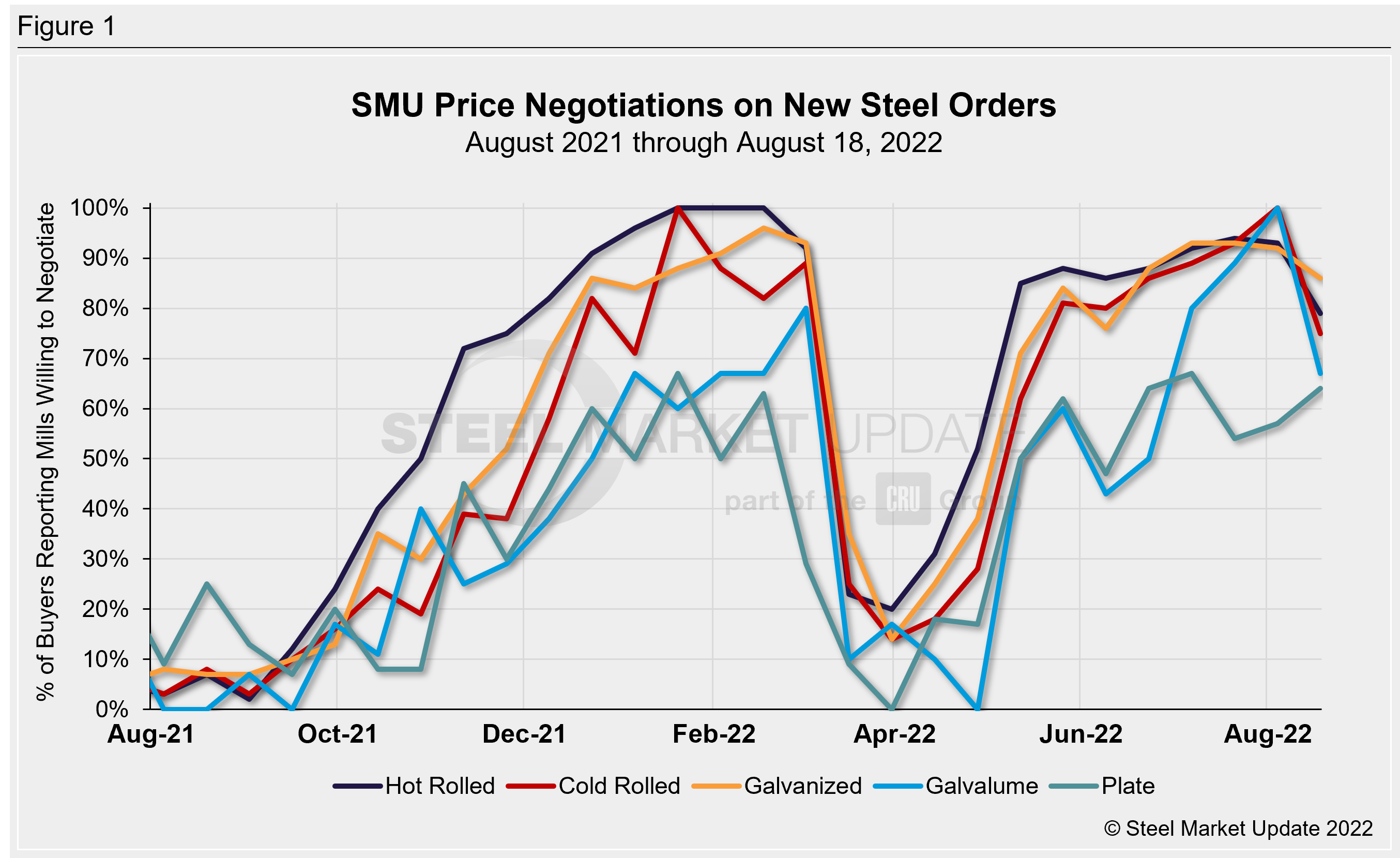SMU Data and Models

Sheet Mills Less Willing to Negotiate: SMU Survey
Written by Brett Linton
August 18, 2022
The percentage of buyers reporting that mills’ prices are negotiable contracted this week, following more than two consecutive months of rising negotiation rates. Four out of five steel executives polled this week reported that mills are willing to talk price to secure an order. According to our steel market surveys, a high willingness to negotiate has been evident in each of our checks since early May.
SMU polls hundreds of steel buyers every other week with the question: Are you finding domestic mills are willing to negotiate spot pricing on new orders? On average this week, 77% of steel buyers reported that mills were willing to negotiate lower prices on new orders, down compared to the 88–89% rates seen since early July. Recall we saw negotiation rates as low as 16% in March.
Broken down by product, 79% of hot rolled buyers surveyed are now responding that mills are willing to negotiate lower prices. Negotiation rates were previously in the 92–94% range in our prior three surveys. 75% of cold rolled buyers polled reported that mills were willing to bargain, down from a 100% rate two weeks ago. 86% of galvanized buyers reported that mill prices are negotiable, down from the 92–93% rates seen in recent months. Galvalume negotiation rates tend to be more volitile due to the smaller market size, with 67% of respondents reporting mills are negotiable this week, down from a 100% rate in early-August.
Negotiations have been slightly less common in the plate market, but have been rising since mid-July. 64% of buyers reported a willingness to negotiate this week, up from 57% two weeks prior and 54% one month ago. Plate negotiation rates have been between 54–67% for nearly two months. Recall we saw plate negotiation rates of 0–18% in March and April.
SMU’s Price Momentum Indicator was adjusted from Lower to Neutral on Aug. 9, and will remain there until the market establishes a clear direction.

Note: SMU surveys active steel buyers twice each month to gauge the willingness of their steel suppliers to negotiate pricing. The results reflect current steel demand and changing spot pricing trends. SMU provides our members with a number of ways to interact with current and historical data. To see an interactive history of our Steel Mill Negotiations data, visit our website here.
By Brett Linton, Brett@SteelMarketUpdate.com

Brett Linton
Read more from Brett LintonLatest in SMU Data and Models

SMU Scrap Survey: Sentiment Indices rise
Both current and future scrap sentiment jumped this month, though survey participants reported responses before key trade news was announced.

SMU Survey: Sentiment splits, buyers have better view of future than the present
SMU’s Steel Buyers’ Sentiment Indices moved in opposite directions this week. After rebounding from a near five-year low in late June, Current Sentiment slipped again. At the same time, Future Sentiment climbed to a four-month high. Both indices continue to show optimism among buyers about their company’s chances for success, but suggest there is less confidence in that optimism than earlier in the year.

SMU scrap market survey results now available
SMU’s ferrous scrap market survey results are now available on our website to all premium members. After logging in at steelmarketupdate.com, visit the pricing and analysis tab and look under the “survey results” section for “ferrous scrap survey” results. Past scrap survey results are also available under that selection. If you need help accessing the survey results […]

SMU flat-rolled market survey results now available
SMU’s latest steel buyers market survey results are now available on our website to all premium members. After logging in at steelmarketupdate.com, visit the pricing and analysis tab and look under the “survey results” section for “latest survey results.” Past survey results are also available under that selection. If you need help accessing the survey results, or if […]

SMU Survey: Sheet lead times stabilize, plate contracts
Mill lead times for sheet products were steady to slightly longer this week compared to our late June market check, while plate lead times contracted, according to steel buyers responding to this week’s market survey.
